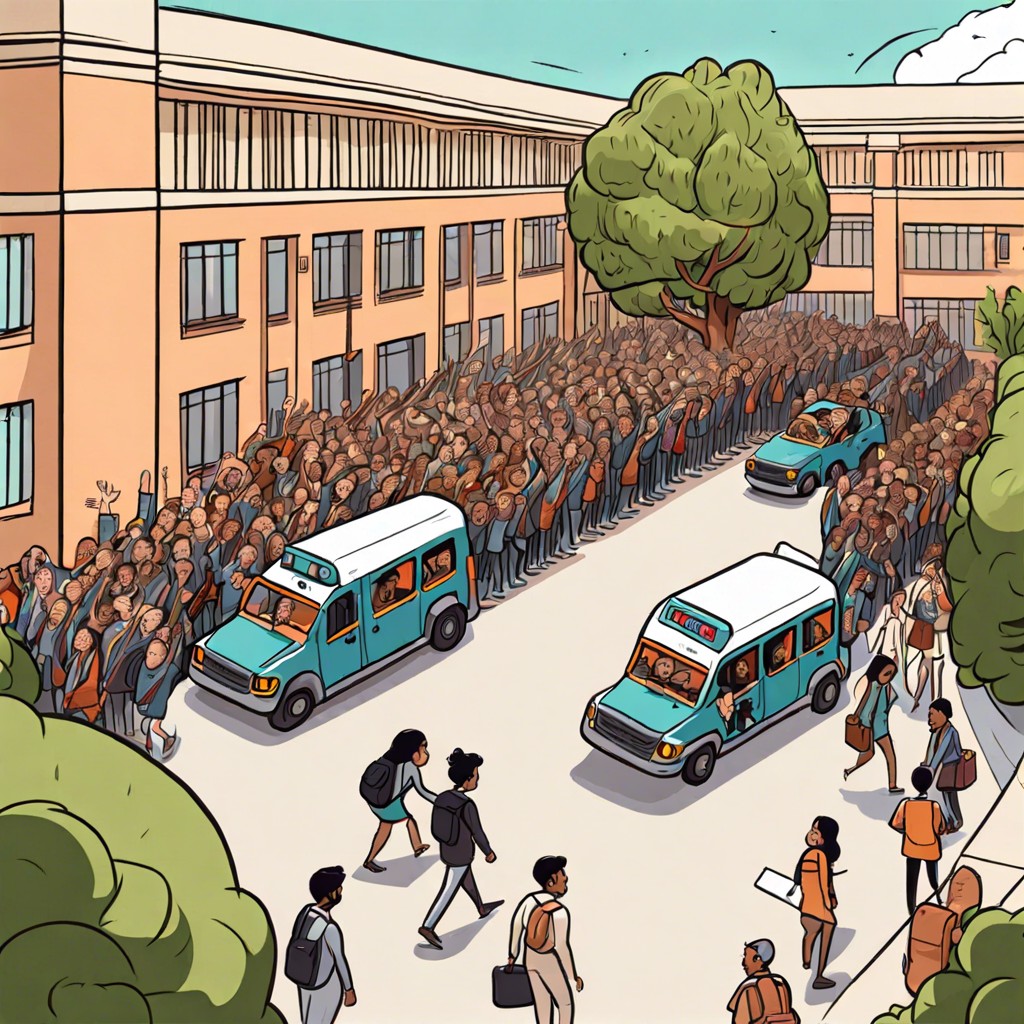If a university burns down, students and staff will be relocated, classes will continue online or in temporary locations, and plans will be made to rebuild.
Imagine the university you know and love suddenly goes up in flames. What happens next? This article dives deep into the immediate chaos and heroics of evacuation, the twists and turns in academic life, the legal and financial hoopla that follows, and the tech tricks keeping education afloat. Plus, how do we support those teary-eyed students and staff? Stick around to unveil the full, fiery drama.
Key takeaways:
- Immediate safety: Stay calm, evacuate, stick together, follow instructions.
- Academic continuity: Classes online, labs through partnerships, housing alternatives.
- Legal & financial: Insurance claims, student contracts, regulations, liability, stability.
- Tech solutions: Virtual classrooms, cloud storage, learning management systems, social media updates, Wi-Fi solutions.
- Psychological support: Counseling, community gatherings, clear communication, mindfulness activities.
Immediate Safety and Evacuation Procedures

Picture this: you’re in the middle of a lecture, trying to stay awake, when suddenly the alarm blares—it’s not a drill. First things first, don’t panic. Yes, Billy’s half-eaten burrito might have started it all, but focus.
Exit calmly. This isn’t a zombie apocalypse; shoving won’t get you out any faster. Use the nearest exit, don’t go back for your laptop. Seriously, it’s backed up, right?
If it’s smoky, keep low. Smoke inhalation’s a big no-no. Crawling is not just for toddlers anymore.
Stick with your group. Your professor’s monotone might just save your life. They’ve got the evacuation route memorized.
Once out, find the designated assembly point. No, it’s not an excuse to camp at the nearest pub. Muster up and await further instructions.
Finally, listen up! Emergency services need clear communication. Don’t wander off like a lost tourist; stay put until given the all-clear.
Impact On Academic Continuity and Student Life
One day you’re hustling between lectures, the next day, your university is a pile of ash. Yikes! So, what happens next?
Classes? They’re going fully digital. Zoom, Moodle, and Google Classroom will become your best friends. Welcome to the university of WiFi and pajamas.
Labs and hands-on projects? Tough luck. Expect partnerships with local institutions or virtual simulations. Prepare to charm your parents into letting their kitchen become a makeshift lab.
Housing? Good news for locals, but dorm-dwellers need temporary lodging. Think hotels, host families, or maybe a quirky Airbnb experience.
Campus social life? It’s like being permanently grounded. Clubs and events will pivot to online hangouts. Can you say Zoom karaoke?
Administration might set up tent offices or rent nearby spaces. Imagine discussing your thesis in a coffee shop. How very avant-garde!
Adjustment is the name of the game, and resilience is the MVP. Academic life will stumble forward, just wearing mismatched socks and rewatching old lecture recordings. Crazy times call for creative solutions!
Legal and Financial Repercussions
When ashes have barely settled, lawyers and accountants swoop in. Let’s dive in:
- Insurance Claims: Universities often have extensive insurance policies. Claiming them isn’t a walk in the park, though. It involves detailed documentation and, quite possibly, a few hundred headaches.
- Student Contracts: If tuition was already paid, will students get refunds? Or perhaps, course credits to use when classes resume? The fine print of student contracts comes into play here, enough to make your head spin.
- Government Regulations: If it’s a public institution, you can bet your bottom dollar there are government regulations to follow for rebuilding and recovery. Bureaucracy, ahoy!
- Liability Issues: Heaven forbid if anyone was hurt, but if so, liability claims might arise. The university, contractors, and even manufacturers of faulty equipment could be in the legal spotlight.
- Financial Stability: Universities rely on tuition, grants, and donations. A catastrophic event strains finances, necessitating creative fundraising or, in some cases, loans.
It’s a whirlwind of legal jargon, paperwork, and, let’s face it, stress. Who knew education came with such drama?
Role of Technology in Continuity Plans
Let’s face it, we live in an age where our gadgets practically run our lives. So why not let technology save the day when catastrophe strikes a university campus?
First, virtual classrooms can come to the rescue. With online platforms like Zoom and Microsoft Teams, students and faculty can continue their academic activities without missing a beat. No physical classrooms? No problem.
Next, cloud storage is a game-changer. All those precious research files, lecture notes, and student records don’t have to go up in smoke. Google Drive, Dropbox, and other cloud services ensure essential data is safe and accessible from anywhere with an internet connection.
Learning management systems, or LMS for those who fancy acronyms, can keep courses on track. Blackboard, Canvas, and Moodle allow both students and professors to share documents, submit assignments, and even take exams online. If universities haven’t hopped on this train yet, it’s high time they did.
Then there’s the power of social media and apps for real-time updates. Platforms like Twitter, Facebook, and specialized apps can keep everyone informed about developments, safety advisories, and contingency plans. A simple Tweet might just be the modern version of the town crier.
And let’s not forget those mobile hotspots and portable Wi-Fi solutions, because no one should have to endure the agony of a disrupted internet connection.
In the end, technology isn’t just a luxury; it’s a lifeline.
Psychological and Community Support
Traumatic events like a university burning down can leave emotional scars. It’s crucial to address these needs head-on. Counseling services should be ramped up, providing one-on-one and group support sessions. This creates a safe space for students and staff to process the event.
Beyond individual counseling, community gatherings can help rebuild a sense of unity. Organize events that encourage sharing stories and collective healing. Think of it as emotional duct tape.
Don’t forget about clear communication. Regular updates on recovery and rebuilding efforts can alleviate anxiety. Transparency fosters trust.
Lastly, don’t underestimate the power of mindfulness and relaxation techniques. Incorporate yoga and meditation sessions into the campus routine. This isn’t just trendy—it’s science-backed stress relief.
So, supports in place? Check. Communities bound together? Double-check. Mindfulness as a glue for sanity? Triple-check.




